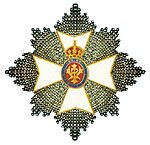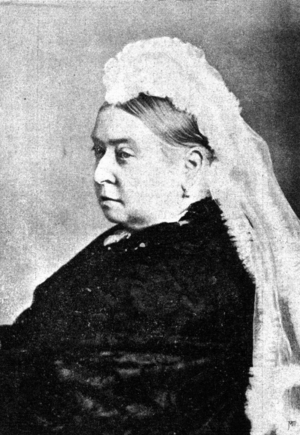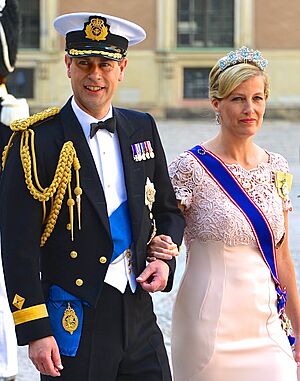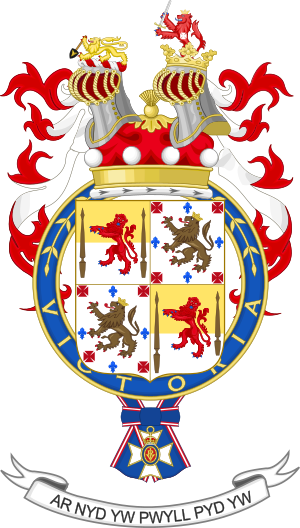Royal Victorian Order facts for kids
Quick facts for kids Royal Victorian Order |
|
|---|---|

Breast star of Knights/Dames Grand Cross
|
|
| Awarded by Charles III | |
| Type | Dynastic order |
| Established | 21 April 1896 |
| Motto | Victoria |
| Awarded for | Personal service to the Sovereign |
| Status | Currently constituted |
| Founder | Victoria |
| Sovereign | Charles III |
| Grand Master | Anne, Princess Royal |
| Chancellor | The Lord Benyon |
| Grades |
|
| Statistics | |
| First induction | 1896 |
| Precedence | |
| Next (higher) | Dependent on state |
| Next (lower) | Dependent on state |
Ribbon of an ordinary member of the order Ribbon of an honorary member of the order |
|
The Royal Victorian Order is a special award created in 1896 by Queen Victoria. It's given to people who have provided excellent personal service to the monarch, members of the royal family, or other important royal representatives. The current monarch, King Charles III, is the leader of the order. The order's motto is Victoria, which means "victory." Its official day is 20 June, and its chapel is the Savoy Chapel in London.
There's no limit to how many people can receive this award at each level. The monarch decides who gets the award. The order has five different levels, plus a medal with three levels. People who receive the top two levels can use "Sir" or "Dame" before their names. All members get special letters after their names. The order's importance compared to other awards can change from country to country.
Contents
History of the Royal Victorian Order

Before the late 1800s, most awards in the British Empire were given out based on advice from government ministers. But Queen Victoria wanted a way to personally thank people who served her directly. So, on 21 April 1896, she created the Royal Victorian Order. This allowed her to give awards to people across the empire for their personal service. The order was founded just a year before her Diamond Jubilee. This gave her time to choose the first people to be honored. The order's official day, 20 June, marks the day Queen Victoria became Queen.
In 1902, King Edward VII created the Royal Victorian Chain. This was a very high award for royal family members and important British citizens. Today, it's separate from the order itself. However, it is still managed by the Royal Victorian Order's office.
From the very beginning, people from other countries could also receive this award. The first foreigners to be honored were from France in 1896.
Who is in the Royal Victorian Order?
The reigning monarch is the head of the Royal Victorian Order, known as its Sovereign. The next most important role is the Grand Master. This position was created in 1937. Queen Elizabeth The Queen Mother held this role until she passed away in 2002. In 2007, Queen Elizabeth II appointed her daughter, Anne, Princess Royal, as the Grand Master.
There are also five main officials who help run the order:
- The Chancellor, who is the Lord Chamberlain.
- The Secretary, who manages the King's money.
- The Registrar, who keeps the records.
- The Chaplain, who is the priest of the Savoy Chapel.
- The Genealogist, who studies family histories.
After these officials, there are people honored with different levels of the order. There are five main levels, and the top two allow people to be called "Sir" or "Dame." All levels come with special letters you can put after your name. There's also the Royal Victorian Medal, which comes in gold, silver, or bronze. People from other countries can become honorary members. There's no limit to how many people can be in each level, and members can be promoted to higher levels.
Before 1984, the Lieutenant and Member levels were called "Members (fourth class)" and "Members (fifth class)." Both used the letters "MVO" after their names. On 31 December 1984, Queen Elizabeth II changed the "Members (fourth class)" to Lieutenants, who now use "LVO" after their names.
What do the Insignia and Robes look like?
When someone joins the Royal Victorian Order, they receive special items called insignia. Everyone gets a badge, which is a white Maltese cross. In the middle of the cross is a red circle with Queen Victoria's special symbol. This circle is surrounded by a blue ring with the order's motto, victoria, and a crown on top.
The badge looks a bit different for each level:
- Knights and Dames Grand Cross wear their badge on a wide ribbon called a sash.
- Knight Commanders and male Commanders wear their badge on a ribbon around their neck.
- Male Lieutenants and Members wear their badge on a ribbon pinned to their left chest.
- Women in all levels below Dame Grand Cross wear their badge on a bow pinned to their left shoulder.
The size of the badge also changes with the rank. Higher ranks have larger badges. Knights and Dames Grand Cross and Knight Commanders also have a star that goes around their cross.

The medal shows the picture and name of the monarch who gave the award. On the back, it has the monarch's symbol inside a wreath. If someone receives a higher medal or is appointed to a higher level of the order, they can still wear their original medal along with their new insignia.
The order's ribbon is blue with red, white, and red stripes on the edges. For honorary members from other countries, the ribbon has an extra white stripe in the middle. The width of the ribbon also varies by rank.
On special formal days, called collar days, Knights and Dames Grand Cross wear a special chain called a livery collar. This chain has gold pieces with roses and inscriptions like Victoria and Queen of the Britons. A larger medallion hangs from the chain, showing a picture of Queen Victoria. Members hang their badge from this medallion. While families can keep the badge after a member passes away, the collar must be returned. Knights and Dames Grand Cross also wear a dark blue satin robe, called a mantle, with red edges. This robe has the order's star on the left side.
The Order's Chapel

Since 1938, the official chapel for the Royal Victorian Order has been the King's Chapel of the Savoy in central London, England. However, the order has grown so much that the Savoy Chapel is now too small for all the members to gather. So, a larger chapel, St. George's Chapel, Windsor Castle, is now used for the main gathering every four years.
The Sovereign and the Knights and Dames Grand Cross have special seats in the Savoy Chapel's choir. On the back of each seat, there's a metal plate with the person's name, family symbol (coat of arms), and the date they joined the order. These plates stay there even after the person passes away. This creates a record of all the Knights and Dames Grand Cross since 1938. Only the banners of the Sovereign and the Grand Master are usually displayed in the chapel because there isn't enough space for more.
The Chaplain of the King's Chapel of the Savoy is also the Chaplain to the Royal Victorian Order. The current Chaplain is Canon Thomas Woodhouse.
Who can join and how are they chosen?

Membership in the Royal Victorian Order is given by the monarch directly. They choose people who have provided personal service to them. The monarch does not need advice from government ministers for these appointments.
People from other countries are usually made honorary members of the Royal Victorian Order. This often happens when the monarch visits their country, or when a head of state from another country visits the United Kingdom.
Canadians
Canadians are usually not appointed to the top two levels of the order. This is because these levels allow people to use "Sir" or "Dame" before their names. The Canadian government has a policy from 1919 that generally avoids these titles for its citizens.
However, Canadians can still be appointed to the order. This resumed in 1972. It includes people who serve the monarch's representatives in Canada, like the Governor General. Since 1984, it also includes officials in the provinces. The monarch originally chose members personally. However, the Governor General of Canada could suggest names. The practice of telling the Prime Minister of Canada about nominees ended in 1982. This was done to keep the order separate from politics.
In Canada, the order is sometimes jokingly called the "Royal Visit Order." This is because many appointments have been made by the monarch during their visits to Canada.
Canadian Association
There is a group called the Royal Victorian Order Association of Canada. It's for all Canadians who have received the order or the Royal Victorian Medal. This is the only such group in the Commonwealth realms. It was started by Michael Jackson. Since 2008, the group has met every two years.
Australians
Like in Canada, Australians can still receive the Royal Victorian Order. It's seen as a personal gift from the monarch. Appointments have continued even after Australia stopped using the wider British honours system in 1994. The highest levels (GCVO and KCVO/DCVO) are given out rarely. They haven't been awarded to Australians since 1990. For example, Governors-General are now usually appointed to the CVO level. Before the 1990s, they would have received higher levels like the GCVO. Awards are often made after a royal visit to Australia. They are given to royal representatives or to people who have provided excellent service to them.
Order of Importance
The Royal Victorian Order is open to citizens of fifteen different countries. Each country has its own system of awards. So, the order's place in the list of important awards changes from country to country. Here are some examples:
| Country | Before | RVO level | After | |
|---|---|---|---|---|
Order of precedence |
Knight/Dame of the Order of Australia (AK/AD) | Knight/Dame Grand Cross | Companion of the Order of Australia (AC) | |
| Companion of the Order of Australia (AC) | Knight/Dame Commander | Officer of the Order of Australia (AO) | ||
| Officer of the Order of Australia (AO) | Commander | Star of Gallantry (SG) | ||
| Member of the Order of Australia (AM) | Lieutenant | Member of the Royal Victorian Order (MVO) | ||
| Lieutenant of the Royal Victorian Order (LVO) | Member | Conspicuous Service Cross (CSC) | ||
| Australian Antarctic Medal (AAM) | Medal | Commendation for Gallantry | ||
Order of precedence |
Commander of the Order of Merit of the Police Forces (COM) | Commander | Officer of the Order of Military Merit (OMM) | |
| Officer of the Order of Merit of the Police Forces (OOM) | Lieutenant | Member of the Order of Military Merit (MMM) | ||
| Member of the Order of Merit of the Police Forces (MOM) | Member | Venerable Order of Saint John (GC/K/D/C/O/M/SB/SSStJ) | ||
| Meritorious Service Medal (MSM) | Medal | Sacrifice Medal | ||
Order of precedence |
Knight/Dame Grand Cross of the Order of St Michael and St George (GCMG) | Knight/Dame Grand Cross | Knight/Dame Grand Cross of the Order of the British Empire (GBE) | |
| Knight/Dame Commander of the Order of St Michael and St George (KCMG/DCMG) | Knight/Dame Commander | Knight/Dame Commander of the Order of the British Empire (KBE/DBE) | ||
| Companion of the Order of St Michael and St George (CMG) | Commander | Commander of the Order of the British Empire (CBE) | ||
| Companion of the Distinguished Service Order (DSO) | Lieutenant | Companion of the Queen's Service Order (QSO) | ||
| Companion of the Imperial Service Order (ISO) | Member | Member of the New Zealand Order of Merit (MNZM) | ||
| New Zealand Bravery Medal (NZBM) | Medal | Queen's Service Medal (QSM) | ||
Order of precedence |
Knight/Dame Grand Commander of the Order of the Indian Empire (GCIE) | Knight/Dame Grand Cross | Knight/Dame Grand Cross of the Order of the British Empire (GBE) | |
| Knight/Dame Commander of the Order of the Indian Empire (KCIE/DCIE) | Knight/Dame Commander | Knight/Dame Commander of the Order of the British Empire (KBE/DBE) | ||
| Companion of the Order of the Indian Empire (CIE) | Commander | Commander of the Order of the British Empire (CBE) | ||
| Companion of the Distinguished Service Order (DSO) | Lieutenant | Officer of the Order of the British Empire (OBE) | ||
| Eldest son of Knight Bachelor | Member | Member of the Order of the British Empire (MBE) | ||
Order of precedence |
Knight/Dame Grand Commander of the Order of the Indian Empire (GCIE) | Knight/Dame Grand Cross | Knight/Dame Grand Cross of the Order of the British Empire (GBE) | |
| Knight/Dame Commander of the Order of the Indian Empire (KCIE/DCIE) | Knight/Dame Commander | Knight/Dame Commander of the Order of the British Empire (KBE/DBE) | ||
| Sheriffs | Commander | Companion of the Order of the Bath (CB) | ||
| Commander of the Order of the British Empire (CBE) | Lieutenant | Companion of the Distinguished Service Order (DSO) | ||
| Eldest son of Knight Commander of the Order of the British Empire | Member | Member of the Order of the British Empire (MBE) | ||
| Northern Ireland Order of precedence |
Knight/Dame Grand Commander of the Order of the Indian Empire (GCIE) | Knight/Dame Grand Cross | Knight/Dame Grand Cross of the Order of the British Empire (GBE) | |
| Knight/Dame Commander of the Order of the Indian Empire (KCIE/DCIE) | Knight/Dame Commander | Knight/Dame Commander of the Order of the British Empire (KBE/DBE) | ||
| Companion of the Order of the Indian Empire (CIE) | Commander | Commander of the Order of the British Empire (CBE) | ||
| Companion of the Distinguished Service Order (DSO) | Lieutenant | Officer of the Order of the British Empire (OBE) | ||
| Eldest son of Knight Commander of the Order of the British Empire | Member | Member of the Order of the British Empire (MBE) | ||
In the United Kingdom, the wives of male members also have a place in the order of importance. This also applies to the sons, daughters, and daughters-in-law of Knights Grand Cross and Knights Commanders. However, relatives of Dames do not get any special importance. Generally, people get their importance from their fathers or husbands, but not from their mothers or wives.
Current Knights and Dames Grand Cross
Sovereign and Grand Master
| Name | Year of appointment | Present age |
|---|---|---|
| The King (ex officio) | Sovereign since 2022 | 77 |
| The Princess Royal KG, KT, GCVO, GCStJ, QSO, GCL, CMM, CD, ADC(P) | 1974 as Dame Grand Cross; Grand Master since 2007 | 75 |
Knights and Dames Grand Cross
| Name | Known for | Year of appointment | Present age |
|---|---|---|---|
| The Duke of Kent KG, GCMG, GCVO, CD, ADC(P) | Royal Family | 1960 | 90 |
| Princess Alexandra, The Honourable Lady Ogilvy KG, GCVO, CD | 88 | ||
| The Duke of Gloucester KG, GCVO, GCStJ, SSI | 1974 | 81 | |
| The Duchess of Kent GCVO | 1977 | 92 | |
| The Duchess of Gloucester LG, GCVO, DStJ, CD | 1989 | 79 | |
| Sir William Heseltine GCB, GCVO, AC, QSO, PC | Private Secretary to the Sovereign | 1990 | 95 |
| Sir Brian Fall GCVO, KCMG | Former Ambassador to Russia and High Commissioner to Canada | 1994 | 88 |
| Major General Sir Simon Cooper GCVO | Master of the Household | 2000 | 89 |
| The Lord Luce KG, GCVO, PC, DL | Former Lord Chamberlain and Governor of Gibraltar | 89 | |
| Vice Admiral The Lord Sterling of Plaistow GCVO, CBE | Chairman of the Golden Jubilee Weekend Trust | 2002 | 90 |
| Prince Michael of Kent GCVO, KStJ, CD | Royal Family | 2003 | 83 |
| Sir John Holmes GCVO, KBE, CMG | Former Ambassador to France | 2004 | 74 |
| Sir Peter Torry GCVO, KCMG | Former Ambassador to Germany and Ambassador to Spain | 77 | |
| The Earl Peel GCVO, PC, DL | Former Lord Chamberlain | 2006 | 78 |
| The Lord Janvrin GCB, GCVO, QSO, PC | Former Private Secretary to the Sovereign | 2007 | 79 |
| Sir Donald McKinnon ONZ, GCVO, PC | Former Secretary-General of the Commonwealth of Nations | 2009 | 86 |
| The Duchess of Edinburgh GCVO, GCStJ, CD | Royal Family | 2010 | 60 |
| Sir Hugh Roberts GCVO, FSA | Surveyor of the Queen's Works of Art | 77 | |
| The Duke of York KG, GCVO, CD | Royal Family | 2011 | 65 |
| The Duke of Edinburgh KG, KT, GCVO, CD, ADC(P) | 61 | ||
| Sir Michael Peat GCVO, FCA | Former Principal Private Secretary to the Prince of Wales | 76 | |
| The Queen LG, LT, ONZ, GCVO, GBE, CSM, CD, PC | Royal Family | 2012 | 78 |
| Sir Alan Reid GCVO | Former Keeper of the Privy Purse | 78 | |
| The Baroness Hussey of North Bradley GCVO | Woman of the Bedchamber | 2013 | 86 |
| Dame Mary Morrison GCVO | 86 | ||
| The Lord Ricketts GCMG, GCVO | Former National Security Adviser | 2014 | 73 |
| The Lord Geidt GCB, GCVO, OBE, QSO, PC, FKC | Former Private Secretary to the Sovereign | 2017 | 64 |
| Sir Stephen Lamport GCVO, DL | Receiver-General of Westminster Abbey | 2018 | 74 |
| Lieutenant Colonel Sir Andrew Ford GCVO | Comptroller, Lord Chamberlain's Office | 68 | |
| The Princess of Wales GCVO, CH | Royal Family | 2019 | 43 |
| Field Marshal The Lord Guthrie of Craigiebank GCB, GCVO, OBE, DL | Gold Stick-in-Waiting | 87 | |
| The Lord Chartres GCVO, ChStJ, PC, FSA, FBS | Dean of the Chapel Royal | 78 | |
| The Lord Parker of Minsmere GCVO, KCB, PC | Former Lord Chamberlain | 2021 | 63 |
| The Duke of Norfolk GCVO, DL | Earl Marshal | 2022 | 69 |
| The Marquess of Cholmondeley GCVO, DL | Lord Great Chamberlain | 2023 | 65 |
| The Earl of Dalhousie GCVO, CStJ, DL | Lord Steward | 77 | |
| The Lord Young of Old Windsor GCB, GCVO, PC | Former Private Secretary to the Sovereign | 59 | |
| David Conner GCVO | Dean of Windsor | 78 | |
| Justin Welby , GCVO, PC | Archbishop of Canterbury | 2024 | 69 |
| The Lord Benyon , GCVO, PC | Lord Chamberlain | 65 | |
| Dame Annabel Whitehead , GCVO | Woman of the Bedchamber | 2025 | 82 |
| Sir Michael Stevens GCVO | Keeper of the Privy Purse and Treasurer to HM The King | 67 |
Honorary Knights and Dames Grand Cross
| Country | Name | Known for | Year of appointment | Present age | Notes |
|---|---|---|---|---|---|
| Japan | Emperor Akihito of Japan KG, GCVO | Emperor of Japan | 1953 as Crown Prince; Emperor from 1989; abdicated 2019 | 92 | |
| Norway | King Harald V of Norway KG, GCVO | King of Norway | 1955 as Prince Harald; King since 1991 | 88 | Recipient of the Royal Victorian Chain |
| Netherlands | Princess Beatrix of the Netherlands LG, GCVO | Queen of the Netherlands | 1958 as Princess Beatrix; Queen from 1980; abdicated 2013 | 87 | Recipient of the Royal Victorian Chain |
| Ethiopian Empire | Prince Mengesha Seyoum GCVO | Prince of Ethiopia | 1965 | 98 | |
| Belgium | King Albert II of Belgium GCVO | King of the Belgians | 1966 as Prince of Liège; King from 1993; abdicated 2013 | 91 | |
| Luxembourg | Henri, Grand Duke of Luxembourg GCVO | Grand Duke of Luxembourg | 1976 as Hereditary Grand Duke; Grand Duke since 2000 | 70 | |
| Morocco | King Mohammed VI of Morocco GCVO | King of Morocco | 1980 as Crown Prince; King since 1999 | 62 | |
| Princess Lalla Meryem of Morocco GCVO | Princess of Morocco | 1980 | 63 | ||
| Malawi | Cecilia Kadzamira GCVO | Official Hostess of Malawi | 1985 | 87 | |
| Morocco | Princess Lalla Asma of Morocco GCVO | Princess of Morocco | 1987 | 60 | |
| Prince Moulay Rachid of Morocco GCVO | Prince of Morocco | 55 | |||
| Spain | King Felipe VI of Spain KG, GCVO | King of Spain | 1988 as Prince of Asturias; King since 2014 | 57 | |
| Kuwait | Khaled Al-Duwaisan GCVO, KCMG | Kuwaiti diplomat | 1995 | 78 | |
| Thailand | King Vajiralongkorn of Thailand GCVO | King of Thailand | 1996 as Crown Prince; King since 2016 | 73 | |
| Princess Sirindhorn, Princess Royal of Thailand GCVO | Princess Royal of Thailand | 1996 | 70 | ||
| Princess Chulabhorn of Thailand GCVO | Princess of Thailand | 68 | |||
| Brunei | Prince Al-Muhtadee Billah, Crown Prince of Brunei GCVO | Crown Prince of Brunei | 1998 | 51 | |
| Nigeria | Emeka Anyaoku GCVO | Secretary-General of the Commonwealth of Nations | 2000 | 92 | |
| Oman | Sultan Haitham bin Tariq of Oman GCMG, GCVO | Sultan of Oman | 2010 as Sayyid Haitham bin Tariq bin Taimur Al Said; Sultan since 2020 | 70 | |
| India | Kamalesh Sharma GCVO | Secretary-General of the Commonwealth of Nations | 2016 | 84 | |
| Jordan | King Abdullah II of Jordan GCB, GCMG, GCVO | King of Jordan | 2024 | 63 | |
| Bahrain | King Hamad bin Isa of Bahrain GCVO, KCMG | King of Bahrain | 75 |
Honorary Knights and Dames Commander
| Country | Name | Known for | Year of appointment | Present age | Notes |
|---|---|---|---|---|---|
| Indonesia | Teuku Mohammad Hamzah Thayeb KCVO | Ambassador to the United Kingdom | 2012 | 73 | |
| South Korea | Lim Sung-nam KCVO | Ambassador to the United Kingdom | 2013 | ||
| Singapore | Foo Chi Hsia DCVO | High Commissioner to the United Kingdom | |||
| France | Bernard Émié KCVO | Ambassador to the United Kingdom | 2014 | 67 | |
| Mexico | Diego Gómez Pickering KCVO | Ambassador to the United Kingdom | 2015 | 48 |
Officers
- Chaplain: The Reverend Canon Thomas Woodhouse, since 2019. He is also the Chaplain of the King's Chapel of the Savoy.
- Chancellor: Richard Benyon, Baron Benyon GCVO, PC, since November 2024. He is also the Lord Chamberlain.
- Secretary: James Chalmers, since July 2025. He is also the Keeper of the Privy Purse.
- Registrar: Lieutenant Colonel Stephen Segrave, since 2019. He is also the Secretary of the Central Chancery of the Orders of Knighthood.
Images for kids
See also
 In Spanish: Real Orden Victoriana para niños
In Spanish: Real Orden Victoriana para niños









